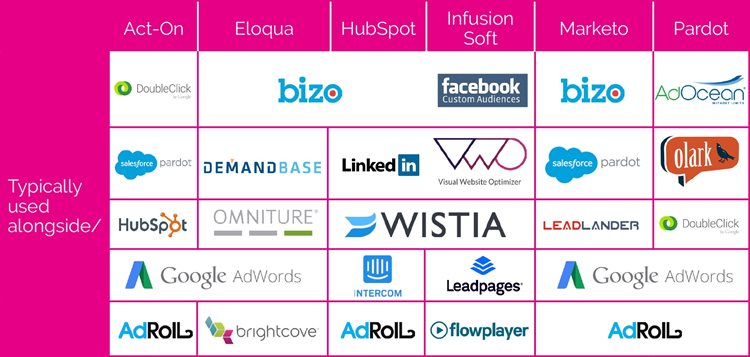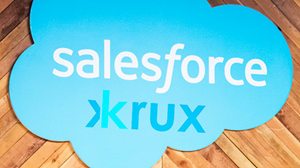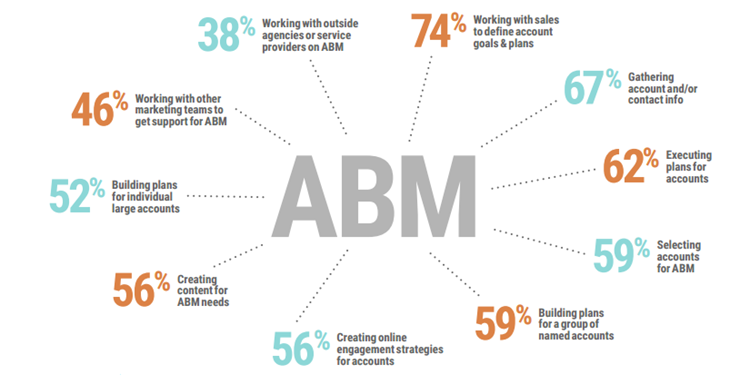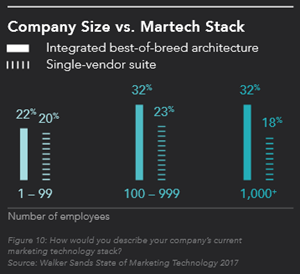The State and Future of Marketing Automation Platforms
Mid-to-large B2B organizations lose an estimated $958 million each year because their  content marketing has gone wrong. Mostly, the main reason behind it is that the majority of content created never sees the light of day. To be exact, 65% of content is unused mostly because the content is not findable or relevant. In today’s marketplace where each customer expects from brands to give them the sense of being understood, well-known and properly served, how come we, as marketers, can expect to convert leads into customers by just throwing a bunch of content against a wall and waiting to see what sticks? Apparently, we cannot, and that’s exactly where marketing automation comes into play as it helps organizations tackle a lack of familiarity by creating highly personalized and relevant content, consistently tracking engagement and nurturing relationships based on their customers' preferences.
content marketing has gone wrong. Mostly, the main reason behind it is that the majority of content created never sees the light of day. To be exact, 65% of content is unused mostly because the content is not findable or relevant. In today’s marketplace where each customer expects from brands to give them the sense of being understood, well-known and properly served, how come we, as marketers, can expect to convert leads into customers by just throwing a bunch of content against a wall and waiting to see what sticks? Apparently, we cannot, and that’s exactly where marketing automation comes into play as it helps organizations tackle a lack of familiarity by creating highly personalized and relevant content, consistently tracking engagement and nurturing relationships based on their customers' preferences.
It has been coded in human nature to pay more attention when it is personalized and familiar. In fact, some scientists conducted a study involving an experiment where participants were asked to make investment decisions either with a close friend (in-network), or a confederate (out-of-network), or a computer (nonsocial control). The majority of participants decided to do business significantly more with their close friends compared with the confederate and computer and more often with the confederate rather than the computer. Not only had they measured the source of trust but also their emotions; the researchers also monitored their brain activity during the experiment finding that it created more favorable feelings for participants to do business with a friend based on a corresponding social value signal in neural circuits of reward. This inherited instinct, which tells us that it is more trustworthy when it is familiar and relevant, also drives the growth of the marketing automation market which is expected to reach $7.63 billion worldwide by 2025, according to a study by Research and Markets.
Findings from Research on the State of Marketing Automation
Based on a recent research report conducted by SimilarTech, a competitive intelligence and lead generation provider, and Bold Digital Architects, an inbound marketing agency, on the trends that have shaped the marketing automation landscape in 2016, the total number of websites using marketing automation technologies in 2016 was 482,765. Here are some other interesting findings from the report:
-
The six biggest technologies, including Pardot, HubSpot, Marketo, Act-On, Eloqua, and Infusion-Soft, hold over 57% of the market share.
-
Hubspot was found to have the largest market share in 2016 with 21 percent.
-
Marketing automation is most popular among B2B companies.
-
Most Billion dollar companies (enterprises) use Marketo
-
Pardot has seen the largest growth in 2016 with an astonishing increase of 108.9 percent. The rest of the six dominant technologies averaged a growth of 48 percent.
Many marketers remain committed to a best-of-breed approach to vendor selection rather than seeking the advantages of single-source solutions. Yet, the same report also disclosed the fact that there is a trend among different tools that are used alongside different technologies. With the marketing automation language, “companies who use this also use”:

In addition, Gartner sees extensibility through published services as a key benefit of this technology. The firms stated that of the 123 references surveyed for its Magic Quadrant, 88 percent reported integrations with at least one hub product other than the one by which they were referred. So, obviously, the vendors that offer the most connections have the upper hand in the competition game.
When it comes to geographic distribution, a study by Research and Markets claims that North America dominates this market, accounting for 54% of the total revenue in 2015. With regard to market penetration efforts outside North America, the report conducted by Bold Digital Architects and SimilarTech unveiled specific focuses of the big players. Pardot, for instance, has identified an opportunity in the Polish market while Marketo has planted seeds in the Japanese market. Infusionsoft is penetrating South American countries. On an interesting note, the study couldn’t find one dominating technology across the EU.
Gartner’s analysts found none of the leaders in the top five most highly rated solutions when they assessed overall satisfaction ratings from vendor references to form the Magic Quadrant report. This tells us a couple of points. First, this means that the market is still not mature enough and has a long way to go. Second, even the vendors that were named as Leaders in the report need to leverage their platforms, which leads us to the third point. Since Leaders are not set in stone, the vendors that landed in the other categories still have an opportunity to surge forward and elbow their way into more competitive spots if they step up their games in terms of innovation and business strategy. Lastly, this is good news for the customers as they will see more innovations coming up from all size of vendors that compete in this unsettled space.
What does the future hold?
As stated earlier in this article, the market is expected to reach $7.63 billion worldwide by 2025, according to a study by Research and Markets. To get a share from this emerging market, marketing automation platforms (MAPs) must evolve. Just like every single technology, MAPs will get smarter as they will transform from being rule-based applications to machine learning-powered tools. Considering the email marketing segment has accounted for the largest market share, in the solution category of the marketing automation market, with smarter MAPs powered by machine learning and artificial intelligence, personalized conversations with customers based on their specific needs will eliminate spam which often plagues email marketing.
As an example of how vendors are taking advantage of artificial intelligence to make their  marketing automation capabilities smarter, I would like to briefly explain the latest enhancements Salesforce made to the Salesforce Marketing Cloud based on its acquisition of Krux, a data management platform (DMP), and its artificial intelligence software, Einstein. Krux analyses and measures the engagement of customers across the different channels to make recommendations to marketers, instead of associating a cookie with an audience segment which is how traditional data management platforms work. According to Salesforce, Krux interacts with more than three billion browsers and devices, supports more than 200 billion data collection events, processes more than five billion CRM records and orchestrates more than 200 billion personalized consumer experiences. As a result, Salesforce developed the ability to target digital advertising activity. With this capability, marketers now can turn off ads to a specific customer when they have a current service issue because there is nothing more impulsive than seeing a promotion about the company when customers are experiencing an issue with them. Additionally, it shouldn’t necessarily be associated with only negative activities. When marketers know customers purchased their product, for instance, they can turn off ads to those as it is not relevant to them anymore or they can retarget them with a campaign for complementary products. That way, brands do not only improve customer interactions but also make their audience feel understood, well-known, and properly served.
marketing automation capabilities smarter, I would like to briefly explain the latest enhancements Salesforce made to the Salesforce Marketing Cloud based on its acquisition of Krux, a data management platform (DMP), and its artificial intelligence software, Einstein. Krux analyses and measures the engagement of customers across the different channels to make recommendations to marketers, instead of associating a cookie with an audience segment which is how traditional data management platforms work. According to Salesforce, Krux interacts with more than three billion browsers and devices, supports more than 200 billion data collection events, processes more than five billion CRM records and orchestrates more than 200 billion personalized consumer experiences. As a result, Salesforce developed the ability to target digital advertising activity. With this capability, marketers now can turn off ads to a specific customer when they have a current service issue because there is nothing more impulsive than seeing a promotion about the company when customers are experiencing an issue with them. Additionally, it shouldn’t necessarily be associated with only negative activities. When marketers know customers purchased their product, for instance, they can turn off ads to those as it is not relevant to them anymore or they can retarget them with a campaign for complementary products. That way, brands do not only improve customer interactions but also make their audience feel understood, well-known, and properly served.
As expected, advanced analytics will become the backbone of MAPs to translate hundreds of millions  of data points into meaningful and actionable insights in order to track consumer behaviors from the perspective of what leads to buying decisions so the marketer can find the most influential way of conversation. To put it into context, MAPs will be able to tell a marketer that a customer who received an email first, read an article that reviews the product second, and then watched the video, increasing a customer’s likelihood to make a buying decision because there is a strong value to understand what sequence of events leads customers to buy or not to buy the product. Marketers can take advantage of the power of data to turn bad experiences into good ones, as well. For instance, it is a very common practice with fine brands to provide a promotional coupon along with a refund when a customer returns the product due to a defect. Now that the marketer knows what approach is the most effective, he/she can customize those promotional coupons accordingly to make it more relevant to the customer who experienced dissatisfaction.
of data points into meaningful and actionable insights in order to track consumer behaviors from the perspective of what leads to buying decisions so the marketer can find the most influential way of conversation. To put it into context, MAPs will be able to tell a marketer that a customer who received an email first, read an article that reviews the product second, and then watched the video, increasing a customer’s likelihood to make a buying decision because there is a strong value to understand what sequence of events leads customers to buy or not to buy the product. Marketers can take advantage of the power of data to turn bad experiences into good ones, as well. For instance, it is a very common practice with fine brands to provide a promotional coupon along with a refund when a customer returns the product due to a defect. Now that the marketer knows what approach is the most effective, he/she can customize those promotional coupons accordingly to make it more relevant to the customer who experienced dissatisfaction.
As discussed earlier, the magic that real-time marketing tools make is developing a contextual understanding of customers, and one way of making it possible is the account-based marketing (ABM) approach, which is a strategic go-to-market approach and creates more specific, relevant, and personalized interactions to drive engagement and conversion at a targeted set of accounts or expand existing ones. Therefore, ABM is expected to be a key element in many companies’ 2017 marketing strategy. In fact, according to Frost&Sullivan, 80% of marketers measuring ROI say that ABM outperforms other marketing investments. Another recent study conducted by SiriusDecisions concluded that 92% of B2B companies call ABM “extremely important” to their overall marketing efforts, while 60% plan to invest in ABM in the upcoming years.

“To break down walls between sales and marketing, ABM is pretty close to a silver bullet in that it aligns programs’ dollars and focus on the accounts that the sales teams care about. So there's inherent buy-in. That said, ABM is only as good as your visibility into your highest potential accounts and best-fit customer segments, which gets clearer over time. So it’s most effective when deployed as part of a comprehensive set of targeting strategies,” said Dave Karel, Head of B2B Marketing, LinkedIn Marketing Solutions.
Challenges in the Future of Marketing Automation
As MAPs are evolving and becoming more sophisticated, the learning curve for marketers may get steeper. As a result, while true contextual marketing, which is relevant, personalized advertising and marketing based on insights gathered from relationships, and historical and situational context with customers, is getting much more possible to achieve, it generates more confusion among marketers due to its complexity thus stunts marketers’ evaluation. Therefore, it is extremely important to choose a marketing automation platform with an intuitive user experience and powered by machine learning and artificial intelligence. To be able to do so, a thorough due diligence plays a huge role to determine the right technology.
69 percent of enterprise marketers report that they are either fully deployed and use regularly  or are in the process of deploying a digital marketing hub, according to a recent Gartner marketing technology survey. Not only Gartner but also other research firms confirm that marketers are embracing best-of-breed architecture as they get the most out of their marketing technology solutions if they add more tools into their ecosystem. In fact, a Walker Sands study with 335 U.S. marketers on the subject of marketing technology adoption unveiled that almost half of marketers (48 percent) describe their marketing technology stacks as best-of-breed, with the majority of those marketers (57 percent) calling their architecture “integrated” rather than “fragmented.” So there is no doubt that integrations continue to play a big role in the future of the market. However, wrangling all those different tools together may represent a challenge for some marketers. Therefore, buyers should be thorough about integration capabilities of any and every marketing automation tool they consider before buying. The tricky part is, though, evaluating the platforms not just from an integrations standpoint, but from a communications standpoint as well. I mean, all tools in your digital ecosystem should be able to communicate with each other so you can get a complete picture of each person that has interacted with your brand regardless of channels and devices utilized.
or are in the process of deploying a digital marketing hub, according to a recent Gartner marketing technology survey. Not only Gartner but also other research firms confirm that marketers are embracing best-of-breed architecture as they get the most out of their marketing technology solutions if they add more tools into their ecosystem. In fact, a Walker Sands study with 335 U.S. marketers on the subject of marketing technology adoption unveiled that almost half of marketers (48 percent) describe their marketing technology stacks as best-of-breed, with the majority of those marketers (57 percent) calling their architecture “integrated” rather than “fragmented.” So there is no doubt that integrations continue to play a big role in the future of the market. However, wrangling all those different tools together may represent a challenge for some marketers. Therefore, buyers should be thorough about integration capabilities of any and every marketing automation tool they consider before buying. The tricky part is, though, evaluating the platforms not just from an integrations standpoint, but from a communications standpoint as well. I mean, all tools in your digital ecosystem should be able to communicate with each other so you can get a complete picture of each person that has interacted with your brand regardless of channels and devices utilized.
My POV
When it is properly set and utilized, marketing automation platforms are great tools to make customers feel engaged, valued, and connected with your brand from the earlier stages in the buying process. Not only is it important to create new advocates; it’s also crucial to maintain customer loyalty which is immersive for any business as it is 7 times more expensive to get a new customer than it is to retain an existing one. Timing is crucial when it comes to engaging both existing customers and potential buyers. Today, marketing automation platforms have proven that they can do much better at determining the right time of what content comes into play than human beings. Whether your organizations run campaigns, straddle time zones, languages, and internal resources or it is a startup where all marketing and communications activities run through a ‘one man show’, marketing automation enables the complex marketing campaign to run smoothly even despite the limited resources while putting time back into marketers’ day by automating simple, repetitive tasks.

Venus Tamturk
Venus is the Media Reporter for CMS-Connected, with one of her tasks to write thorough articles by creating the most up-to-date and engaging content using B2B digital marketing. She enjoys increasing brand equity and conversion through the strategic use of social media channels and integrated media marketing plans.